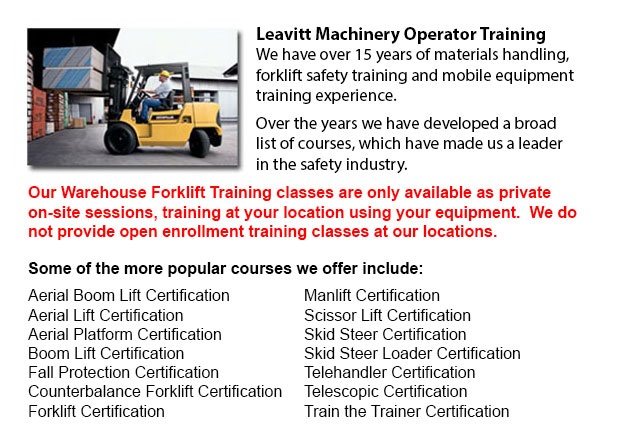
Kingston Warehouse Forklift Training Programs - Warehouses could either be retail, industrial or commercial facilities, functioning from bulk product retailing to product distribution services. Regardless of the type of warehouse, personnel inside warehouse settings must be trained correctly in safety measures related to material handling and storage, conveyor systems, loading docks, and pallet jacks and forklifts. Good housekeeping is essential to a safe and orderly warehouse setting.
The loading dock system is often build into the warehouse at a height from the ground making it easy to move things moving out and coming in of the warehouse. Employees will likewise unload and load materials and merchandise from the ramps and elevated docks. Particular attention should be paid to safety practice during this stage. To be able to prevent falls, install yellow striping along the edge of ramps and docks. Pay attention to the area all-around delivery trucks which are parked at the loading dock, specifically the area between dock and the truck. Be certain that while unloading, truck wheels are chocked.
To distribute products in the facility, some warehouses make use of a conveyor system. These systems are designed with moving wheels and belts that could pose a pinch point hazard. Keep hair and parts of the body far away from conveyors to avoid injury. Elevated conveyors pose a hazard to employees underneath if safety nets are absent. Personnel ought to know how to stop conveyors in the event of emergency. Be aware of the location of emergency stop buttons and off switches. When servicing conveyors, lock out/tag out measures are mandatory.
To be able to make it easier to move materials, pallet jacks and forklifts are most usually used. The operator of the lift truck would require training and certification. Operators of pallet jacks do not need certification, but should be trained on the machinery. Training courses instruct operators in the right methods for hoisting objects and transporting them to their assigned place. Neither pallet jacks nor forklifts should ever be used to transport or lift employees.
Rack system and storage shelving help to create an orderly and efficient work space if they are sturdy, braced, and allow enough room for individuals and machinery to pass. Careful and slow placement of good is needed to prevent accidents caused by products falling off the facing aisle. Aisles must be kept clear by keeping products flat and inside the shelving units. Pallets are made use of for stacking products. They must be in good condition, and palleted products should be baled or shrink-wrapped, whenever possible.
Personal protective equipment (PPE) should be worn, as appropriate, to protect employees' heads, limbs, feet and hands. Hard hats or bump caps, steel-toed shoes and gloves are common PPE.
Slippery floors that are pocked with pits and dents could present significant hazards, making good housekeeping extremely essential. Warehouse docks and floors must be clear of oil, dirt and debris. The space should be kept clear of trash, boxes and baling materials.
-
Narrow Aisle Forklift / Order Picker Training / Electric Pallet Jack / Electric Pallet Truck Training in Kingston
A pallet lift is a piece of equipment dedicated in the moving of pallets of various dimensions and weights. They might be utilized as an accessory for forklifts, cranes and other styles of heavy machinery or be applied on their own. Pallet lifts are... More -
Kingston Forklift Training School
Kingston Forklift Training School - Forklift Training School - Industry and federal regulators have established the criteria for forklift safety training based on their existing regulations and standards. People wishing to operate a forklift must fin... More -
Kingston Scissor Lift Certification
Kingston Scissor Lift Certification - Scissor lift platforms are utilized at work locations to enable tradespeople - such as iron workers, welders and masons - to reach their work. Making use of a scissor lift platform is usually secondary to their t... More -
Kingston Boom Lift Safety Training
Kingston Boom Lift Safey Training - Boom lifts are a type of elevated work platform or aerial lifting device that are normally utilized in warehousing, construction and industry. Boom lifts could be made use of in practically whichever environment du... More -
Kingston Fall Protection Ticket
Kingston Fall Protection Ticket - Fall-related incidents are the number one reason of death in the construction business. The possibility for fall accidents very much increases based upon the type of work which is being accomplished within your workp... More -
Telehandler Training in Kingston
Telescopic handlers normally called telehandlers for short, are an extremely popular piece of heavy construction machinery. They are widely utilized in the construction and agricultural trades. These machines have farthest reaching ability and are ab... More -
Kingston Heavy Equipment Ticket
Kingston Heavy Equipment Ticket - Depending on the nature of the job at hand, the kind of construction machinery that a heavy equipment operator utilizes varies. Every type of equipment is built to do particular jobs in the most effective method comm... More -
Kingston Loader Operator Certification
Kingston Loader Operator Certification - Why Loader Operator Certification Is Required By Businesses - Loader Operator Certification is normally required for personnel working within construction, warehouse or industrial setting to guarantee the safe... More

Forklift Certification Kingston
TOLL FREE: 1-888-254-6157
Kingston, Ontario
forkliftcertificationkingston.com
Email Us
About Us


